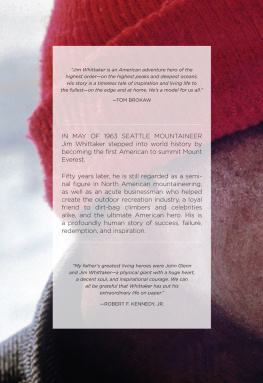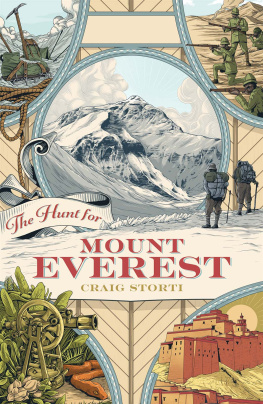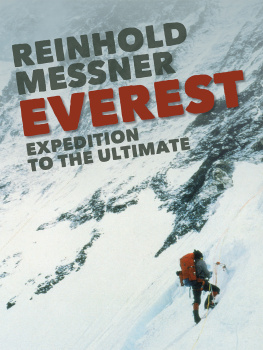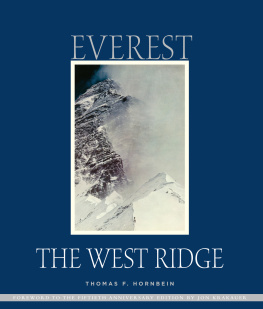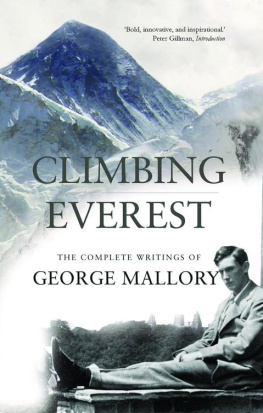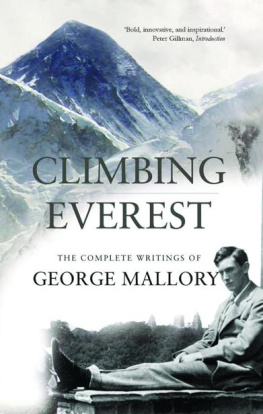JIM
WHITTAKER
NEW FOREWORD by ED VIESTURS
A
LIFE
ON THE
EDGE
MEMOIRS of EVEREST and BEYOND
A LEGENDS AND LORE TITLE
ANNIVERSARY EDITION

TO DAD, MOM, DIANNE, CARL, SCOTT, BOBBY, JOSS, AND LEIF
He who moves not forward goes backward.
Goethe
CONTENTS

Jim Whittaker on the summit of Mount Everest, May 1, 1963 (courtesy Nawang Gombu/National Geographic Society)
FOREWORD TO THE ANNIVERSARY EDITION
A t 1:00 PM on May 1, 1963, two heavily clothed figures, walking side by side into the teeth of a biting wind, took the last of many steps and stood on the summit of Mount Everest. Rather than trying to decide who would go first, they opted to climb together. One was a towering giant of a man from the Pacific Northwest; the other, a much smaller yet equally powerful native of Nepal.
Standing on the roof of the world that day were American Jim Whittaker and a native of Darjeeling, India, the Sherpa Nawang Gombu. Having climbed the mountain via the South Col route, Jim became the first American to summit Everest. Both he and Gombu were part of a larger team, two members of which, in the days to follow, would pioneer one of the boldest ascents ever done in the Himalayathe ascent of the West Ridge and the first complete traverse of the mountain. The expedition was a tremendous success, even though there was some dissension between the two teams as each vied for supplies and manpower to complete its own ascent.
Jim and Gombu became only the tenth and eleventh humans to stand on Everests summit, and that, in and of itself, garnered attention and a certain amount of celebrity. The fact that Jim became the first American to climb Everest took his celebrity to another levelakin to that of Mercury astronaut John Glenn, the first American to go into outer space. A visit to President John F. Kennedys White House, and the presidents award of the Hubbard Medal to the entire Everest team, soon followed. The West Ridge climb by Tom Hornbein and Willi Unsoeld was a much more significant event in the eyes of mountaineers and alpinists, but in the publics eye, nothing tops being the first; being second hardly counts. Admiral Robert Falcon Scott of the 1918 South Pole expedition and Buzz Aldrin of the 1969 moon landing could both attest to that.
For Big Jim, climbing meant more than just becoming the first American. It has been one of many highlights of a life well lived. Growing up in Seattle, and having the water and mountains in his backyard, grounded Jim and instilled within him a respect for the power of Mother Nature. He learned to use his strength and intelligence to achieve goals in the mountains not by conquering, but by incorporating himself into his surroundings and then attaining success through the open doors of opportunity. He brought these attributes of his character into his personal and business life as well, and because of that has gained the respect of many.
The remarkable 1963 American ascent of Everest occurred when I was but four years old. As a teen growing up in Illinois, I began reading about adventures, and mountaineering books fell into that category. I became enamored with the thought of someday going on a Himalayan expedition. Climbers such as Whittaker, Gombu, Hornbein, Hillary, and Messner became my heroes. I was drawn to and eventually moved to the Northwest because of the great climbers who had come from this beautiful place and the wealth of climbing opportunities in the region. Little could I imagine that I would eventually become friends with some of these mountaineering legends. In fact, Jim himself would be my expedition leader when I made my first ascent of Everest in 1990, as part of the International Peace Climb.
I saw firsthand examples of Jims strength of character during the Peace Climb, in which Chinese, Soviets, and Americans had to somehow work together to achieve a common goal. His calm demeanor, the respect of his peers, and his steadfast diplomacy became the glue that kept our three dichotomous teams together. In the face of overwhelming odds, created not only by the mountain itself but by the language and cultural barriers of three different nationalities, Jims steady leadership resulted in what was, at that time, the most successful Everest expedition ever.
Because of my relationship with Jim, it is an honor to be a part of this reissue of his classic autobiography, A Life on the Edge. As a mountaineer, I always took the time to read about and absorb the history of mountaineering, and to learn about individuals who lived a life of adventure. I also wanted to somehow follow in their footsteps. Jim Whittaker is truly one of those individuals whom I respect and look up to, and his book is an important part of my library. He has lived, and is still living, the kind of life that many dream of but only a rare few achieve.
I believe we can all learn the lessons of life from people like Jim, who broke new ground and has been willing to live a life on the edge.
Ed Viesturs
FOREWORDS TO THE FIRST EDITION
EDWARD M. KENNEDY AND JOHN GLENN
J im Whittaker was the first American to stand atop Mount Everest in 1963and those of us who are privileged to call him a friend know he stands equally tall at sea level.
President Kennedy met Jim in 1963 when he honored him and his Mount Everest team at the White House. Other members of the Kennedy family met Jim in 1965 when he agreed to lead a National Geographic and Boston Museum of Science survey expedition up the tallest unclimbed mountain in North America, which had recently been named in honor of President Kennedy by the Canadian government. Robert Kennedy was part of the team that climbed Mount Kennedy with Jim, and Jim and Bobby knelt at the summit in memory of my brother. I had intended to make the climb too, but was unable to do so in the wake of the plane crash that nearly took my life in June of 1964. Bobby was fascinated by Jims leadership, good humor, and courage on that expedition, and by the time they descended they had become friends.
Jim and his family were wonderful company on Christmas ski trips and river-rafting summer vacations, and Jim was a terrific organizer during Bobbys 1968 presidential campaign. I saw an example of Jims courage and concern for others firsthand during a ski holiday in Sun Valley. One snowy day he was riding up in the chair lift and saw a fallen skier at the foot of the chair tower ahead of him, who looked shaken up. As he got closer he suddenly realized that it was my son Teddy. Without a thought about his own safety, he immediately slid off the chair, hung by his hands for a second and let go. He fell 20 feet and his skis were knocked off, but fortunately he was not hurt. Jim then skied down to Teddy, made sure he was not injured, and helped him get back down to the Roundhouse. In a sense, I inherited Jim from Bobby, and we have been great friends ever since.
Jims extraordinary life has been filled with many significant milestones, and this memoir lets the world relive the amazing adventures that have shaped this remarkable man. He vividly describes the awe, terror, and exhilaration of climbing the highest mountains in the world and gives us insight into the unique physical and organizational skills that make these ascents successful. As a young man, he started climbing with his brothers in the pristine beauty of the Pacific Northwest. His inner compassan awareness of the beauty and the power of nature and a visceral realization of the importance of preserving the environmentled him ever upward to the roof of the world. As his skiing and mountaineering abilities grew, he also took on the responsibility of a mountain rescue service with his twin brother, Louie. He had numerous harrowing moments, and readers are likely to come away feeling it is a miracle Jim Whittaker is still alive. For many others, Jim was himself the miracle who kept them alive.

